Chapter 1 - Introduction to Cognitive Psychology
1/66
There's no tags or description
Looks like no tags are added yet.
Name | Mastery | Learn | Test | Matching | Spaced |
|---|
No study sessions yet.
67 Terms
Cognition
The mental process of acquiring knowledge through thought, experience, and the senses (thinking, learning, remembering, etc.,)
Cognitive Psychology (what is it?)
The study of how the brain works including processes such as perception, attention, memory, language, decision-making, thought, brain activity, and other mental processes
Current research on cognitive psychology (what does it attempt to do?)
Attempts to connect cognition with other areas of psychology such as linguistics, cognitive science, and neuroscience (e.g., consciousness, brain function, teaching, learning)
Metacognition (what is it?)
Awareness of one’s own cognitive abilities and processes
William Wundt (who was he; what did he study)
One of the founders of psychology, who studied conscious experience through self-reports of person’s thoughts (Introspection)
Early Psychologist Studies (what did they study; what was their goal?)
How people perceived sounds, colors, and other sensory experiences using introspection
There goal was to study consciousness as it occurs
Introspection (what is it?)
Reflecting on and reporting one’s own subjective experience
Hermann Ebbinghaus (who was he; what did he study; what did he find?)
A german psychologist who studied the processes of remembering and forgetting by testing his own memory.
He measured the decline in memory over time and mapped out the forgetting curve that researchers still find in current studies
The study of cognition fell out of favor with the rise in popularity of ___
Behaviorism
John Watson & B.F. Skinner (who are they; what did they argue?)
Prominent behaviorists that argued introspective methods were biased by the perspective of the subject
Who was behind the critique of the behaviorist approach?
Noam Chomsky
Noam Chomsky (who was he; what did he critique; how?)
A prominent linguist that attacked the behaviorist approach to language learning (Skinner’s operant conditioning take on language learning) → He made a counterargument that children produce sentences that were never produced before
What notion led us to return to the study of non-observable cognitive processes?
Chomsky’s notion that language abilities result from cognitive processes inherent in humans
Brain as a Biological Computer (what is it; who developed it?) (REVIEW SHEET)
A metaphor for the mind developed by Walter Pitts and Warren McCulloch that presents the brain as being capable of storing information and altering it just as a computer does
Information-processing model (what is it; what did it provide to research community?) (REVIEW SHEET)
A cognitive framework that explains and describes how humans process information, similar to a computer; It provided a universal language that allowed researchers to discuss the processes of the mind
Ulric Neisser (who was he; what did he do?)
A cognitive psychologist (considered the father of the field) that wrote a book in 1967 that helped the development of cognitive psychology (coined that term)
Representationalism (what is it?) (REVIEW SHEET)
The idea that information from the world is represented in some form in our minds (e.g., how do you store the concept of a grasshopper?); that cognitive processes can “operate” on the representations; the computer metaphor is the prominent model for representationalism
Early Representationalist Models (what is it; who created; what did it lead to?)
Developed by Rumelhart & Norman in 1988 → Information was thought to be stored as symbols that can operate on in the same way we can mathematically operate; led to the study of operations as processes of cognition (e.g., feature detectors)
Feature Detectors
Stored information about features encountered in the world (e.g., lines, colors, curves)
Embodied Cognition (REVIEW SHEET)
Our interactions with our environment influence our cognition (e.g., shoulder pads and athletes)
Four Principles of Scientific Method (what are they; meaning?) (REVIEW SHEET)
Empiricism - understanding through systematic observation
Determinism - behaviors have an underlying cause (cause + effect)
Testability - able to be evaluated through observation
Parsimony - prefer simple explanations over more complex ones
Case Studies (what are they; advantages; disadvantages?) (REVIEW SHEET)
Intensive analyses of a single individual (or single observation unit); Advantages - number of intensive observations; Disadvantages - explains the behavior of a single individual, difficult to make broad generalization
Correlational Studies (what are they; advantages; disadvantages?) (REVIEW SHEET)
Systematic observation of groups, recording frequency/intensity of many variables at once; Advantages - observation of many variables at once; Disadvantages - correlation ≠ causation; shouldn’t make generalizations
Experimental Studies (what are they; advantages; disadvantages?) (REVIEW SHEET)
Examining causal relationships between variables, simplifying contexts surrounding the behavior of interest; Advantages - the ability to make causal inferences; Disadvantages - Inability to generalize to other concepts (external validity)
Quasi-independent Variable
A variable that is pre-existing or unable to be separated from the participant, such as gender
Dependent Variable (REVIEW SHEET)
The behavior that is measured
Independent Variable (REVIEW SHEET)
The factor that can be manipulated (variable you have control over)
Commonly Used Measures in Cognitive Psychology (what are they; meaning?)
Accuracy - measurement of correctness
Response time - measurement of how long it takes to respond to a stimulus
Priming
An effect in which the exposure to one stimulus influences the response to a later, related stimulus
Multimedia [as a learning strategy] (what is it; effects?)
Moving pictures/sound effects; can contain larger amounts of extraneous info, cognitive resources can be devoted to irrelevant details (instead of processing the learning material)
Static media [as a learning strategy] (what is it; effects?)
Pictures/text; reduces irrelevant info, more resources available to process learning material; can engage in generative processing (mental animations, explanations)
Multimedia vs Static Media (conclusion)
Static media can be better, or just as good as multimedia for learning (multimedia does not provide a boost to learning)
Restudying vs testing [learning strategies] (conclusion)
Testing provides greater benefits to retention (vs restudying); helps practice recalling/retrieving the info from long-term memory (same process involved during exam)
Single code vs dual code [learning strategies] (meaning; conclusion; why?)
Single code - a single channel of feedback (e.g., audio, video, or text), Dual code - two modalities of feedback (e.g., audio + text)
Dual code presentation provides better retention when information presented in dual modalities (they use different resource pools, less likely to have an overload of info and create greater amounts of retrieval routes)
Kornell & Bjork, 2008 (what was it about; what was the conclusion?)
Spaced learning vs Massed learning
Spaced learning is more effective than “massing” it
Helps create different learning “episodes”
Practice retrieving info from LTM, which is what happens on exam
Improves attention (having breaks)
Inductive learning (learning from previous examples) which can help you relate concepts to each other
Generating vs Non-generation (what does it mean; which is better?)
Generation (creating your own) vs Non-generation (using pre-existing)
Generation - demands more cognitive resources and attention that promote retention and help encode info better. You are also more likely to engage in active processing
Structuralism (what is it; what methods were used?)
A theory of consciousness (developed by william wundt) that breaks the mind into their smallest pieces and studies how they work together
Introspection (self-report) and experiments using physical stimuli (e.g., light)
Main Limitations with Structuralism
Subjectivity
Inability to be scientifically studied (especially “higher” consciousness) - not testable, how do you compare observations, asses accuracy of observation…?
Functionalism (what is it; what methods were used?)
A theory of consciousness (developed by William James) asserting that consciousness should be studied as a continuous flow (don’t strip to element such as in structuralism), focusing of the function of the mind (how does it work, what is its purpose
John Watson (what is aim and focus on psychology?)
The aim of psychology should be controlling & predicting behavior and should focus on method (studies that yield replicable and observable results)
Little Albert Experiment (how was it conducted? what was result?)
(Conducted by John Watson) An infant was exposed to various stimuli, including white rats. Initially, he showed no fear. However, when paired with a loud noise (metal bar struck with hammer), that elicits fear, Albert began associating the rat with fear. The fear somewhat generalized to similar objects (rabbit, coat, mask), but never consistent.
Overall, at best, weak and inconsistent conditioning
B.F Skinner (what is view and focus on psychology; view on human learning?)
He practiced a stronger behaviorism than Watson, that reduced results to stimulus-response (S-R) pairings. Psychology can only be conducted using observable terms, moving away from theoretical terms (memory, motivation).
Human learning is operant conditioning (e.g., child’s speech rewarded by parent’s smile)
Skinner Box
Box used for operant conditioning. Reinforcement of behavior to shape it (reinforcer and operants). Behavior that is more likely to be repeated in the future after reinforcement - reinforced
Behaviorism (criticism)
Criticized for the inability to deal with complex issues/functions/behaviors (such as memory, language, learning, emotion)
Judgment of Learning (JOL)
Assessment about how well something is learned
Direct Access View
Having direct access to our memory traces (directly assess the current strength of a memory or change in strength)
Castel et al., 2007 - Metacognitive Judgements (what was it; method; results)
Focused on how people make metacognitive judgement about their memory (how well they think they remembered something)
Participants predicted how well they would remember word pairs and then compared that to actual memory performance
Overall, predictions did not match actual memory recall (does not support direct access view)
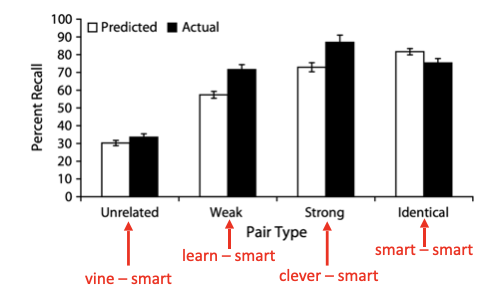
Mueller et al., 2012 - Word Pairs (what was it; method; results)
Focused on how people judge their own learning when exposed to word pairs that vary in difficulty (levels of cognitive effort)
Participants studied words paris displayed in different formats (related and unrelated pairs), after each pair, participants were asked to predict how well they’d remember
Participants underestimated how well they would remember difficult (unrelated) pairs and overestimated how well they would remember easy (related) pairs. JOLs are often inaccurate
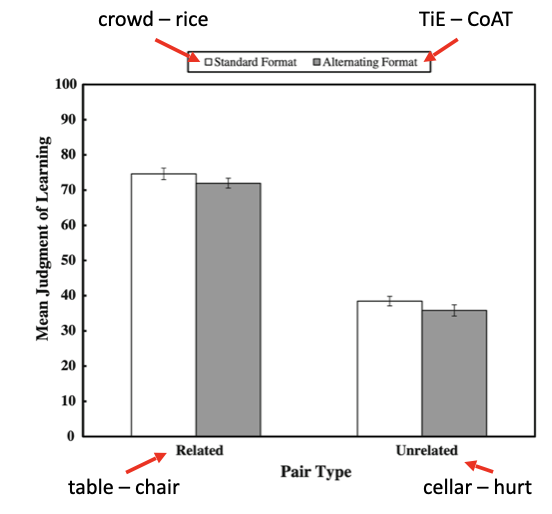
Belief/theory-based Judgements
Based on remembered content of beliefs or knowledge (based on information from long-term memories)
Topolinksi et al., 2016 - Anagrams (what was it; method; results)
Focused on how the ease or difficulty of solving anagrams impacts people’s prediction about the future of those anagrams
Participants were given a set of anagrams, some were easy (high fluency) and some were difficult (low fluency), after solving, they made judgement about whether they would remember the solution
Easier pronunciation more likely to be considered solvable - metacognitive judgements were made based on how easy anagram was to read

Cue-Utilization View (what is it; how can judgement be accurate?)
Describes how people use various types of cues to make predictions about their memory performance (base metacognitive judgements on inferences made from cues)
Judgements can be accurate if cues (used at judgement) are similar to factors that influence memory performance
Intrinsic Cues
Characteristics of the learning material (such as complexity, meaningfulness, or relationship between items in word-pairs)
Extrinsic Cues
External factors related to the learning environment (conditions at encoding) such as methods of studying (massed vs spaced, # of repetitions)
Experience-based Judgements
Can be based on an experienced process (e.g., internal experience of a memory)
Encoding Fluency
Ease or difficulty with which information is processed and encoded into memory
Perceptual Fluency
Ease or difficulty with which sensory information is processed (ease of perceiving (i.e., hearing) led to higher judgements
Immediate JOLs
Judgements made using info from short-term memory(e.g., can mistake the fluency of retrieval with how well something is known)
Delayed JOLs (what is it; benefits?)
Assessing information from Long-term memory (Judgements based on more stable, diagnostic information)
Can help accuracy and improve monitoring accuracy
Improving Accuracy of Metacognitive Judgements
Delay making JOLs (e.g., 20 min. after studying material, retrieve from LTM)
Test over material (recalling vs rereading/restudying) - test using cue only
Multiple study-test rounds
Monitoring (what is it, how is imperfect monitoring still beneficial?)
Evaluating our own cognition (e.g., assessing what i’m currently thinking about)
Imperfect monitoring (criticism of introspective methods) even if flawed, can still be used in conjunction with other empirical data, and can show how metacognitive judgement can influence behavior/action
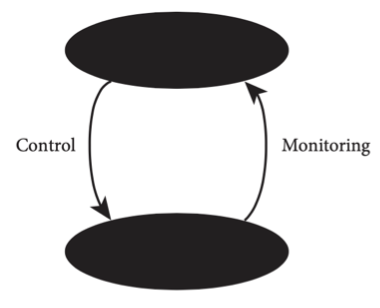
Control
Actions that change or regulate our cognition (based on the information from our monitoring)
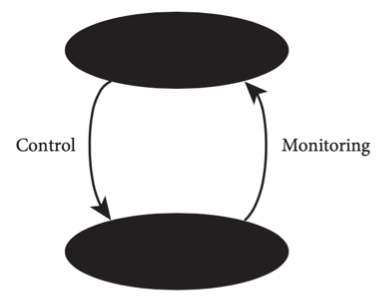
Meta level
The monitoring or control of the cognitive processes occurring at object level; awareness of ongoing cognition (“higher level” than object-level)
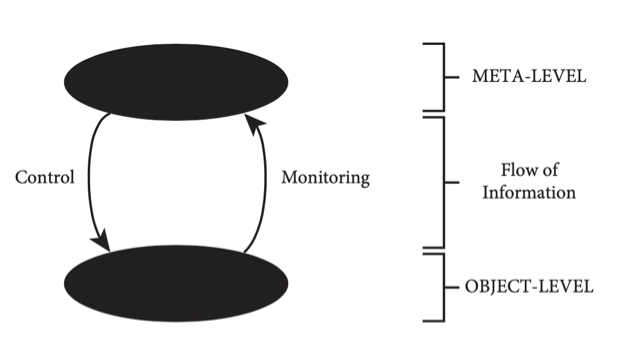
Object level
The cognitive task itself; our current cognition, what we’re currently thinking about or working on (e.g., reading, learning/encoding, recalling, others thoughts we may have, behaviors)
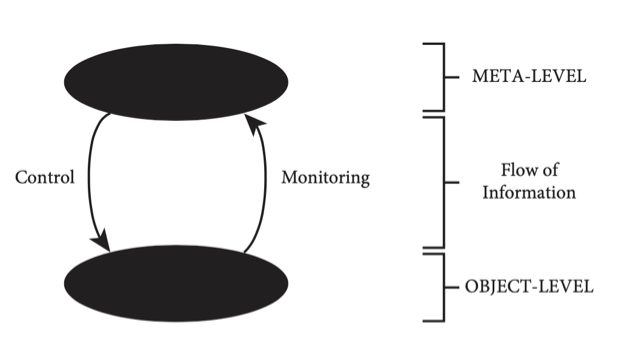
Fill in the blanks using [monitoring; control; meta level; object level] While reading (____) a textbook chapter, can think of the goals you have, such as understanding the material (____). Based on assessment (____) of comprehension, we can select (____) to reread a chapter that we didn’t fully understand
Object level; meta level; monitoring; control
Discrepancy Reduction (what is it; what does it prioritize; drawbacks?)
A way to allocate study time by focusing on reducing the difference between what is learned/known & what is to be learned
Prioritizes unlearned material (driven by low JOLs, such as difficult material)
The drawbacks: time constraints: might not have enough study time to master material; spend too much time on very difficult material
Region of proximal learning (what is it; what does it prioritize; drawbacks?)
A way to allocate study time by taking into account study time available (eliminating well-learned material, then study unlearned material if learnable (e.g., not too difficult (low priority)
Prioritizes unlearned material considered easy (then move to difficult material); focuses on greater “pay-off”
The drawback: may not learn difficult material as it was not studied (i.e., considered unlearnable given time constraints)
Agenda-based regulation (what is it; drawbacks?)
A way to allocate study time where an agenda determines what gets prioritized; in addition to JOLs, studying influenced by available time, plans/goals, incentives
The drawbacks: change in plans/goals (e.g., exam review reveals a topic is not tested as much)